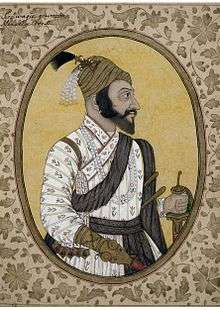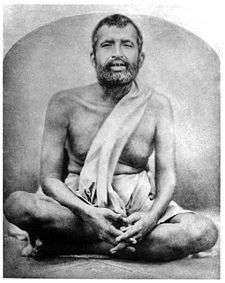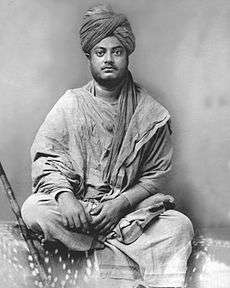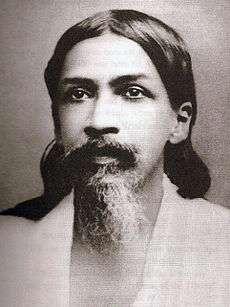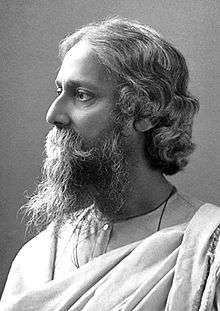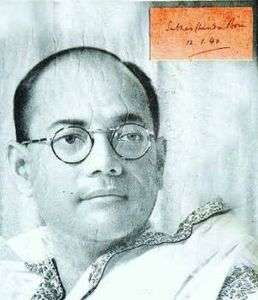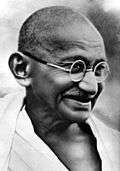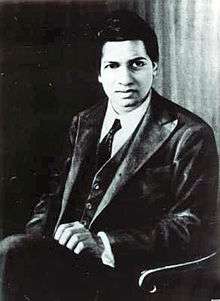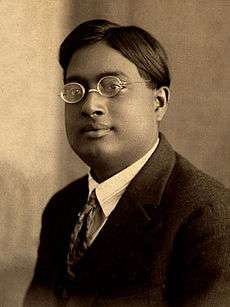Hinduism in India
|
Chhatrapati Shivaji, Bajirao Ballal Peshwa, Vinayak Damodar Savarkar, Ramakrishna, Swami Vivekananda, Aurobindo Ghose, Rabindranath Tagore, Subhas Bose, Mahatma Gandhi, Srinivasa Ramanujan, CV Raman, Raja Ram Mohan Roy, Ishwar Chandra Vidyasagar, Jagadish Chandra Bose, Satyendra Nath Bose, Narendra Modi, Dayananda Saraswati, Sri Sri Ravi Shankar | |
| Total population | |
|---|---|
| 1.10 Billion (2016 estimate) | |
| Regions with significant populations | |
| Majority in all Indian states except Jammu and Kashmir, Lakshadweep Islands, Punjab, Meghalaya, Mizoram and Nagaland. Large concentrations in Himachal Pradesh, Uttarakhand, Haryana, Delhi, Rajasthan, Gujarat, Madhya Pradesh, Maharashtra, Chhattisgarh, Odisha, Telangana, Andhra Pradesh, Tamil Nadu and Tripura, Uttar Pradesh. | |
| Languages | |
| Indian languages · Indian English |
Hinduism is the major religion of India, with over 80% of the population identifying themselves as Hindu, that accounts for roughly 97 crore (~ 1 billion) Hindus in India, while 14.2% of the population follow Islam and the remaining 6% adhere to other religions (such as Christianity, Sikhism, Buddhism, Jainism and various indigenous ethnically-bound faiths)(2011 census).[1][2][3][4] The vast majority of Hindus in India belong to Shaivite and Vaishnavite denominations.[5] India is one of the three countries in the world (Nepal and Mauritius being the other two) where Hinduism is the majority.
The Vedic culture originated in India between 2000 and 1500 BC.[6] As a consequence, Hinduism, considered to be the successor of Vedic religion,[7] has had a profound impact on India's history, culture and philosophy. The name India itself is derived from Greek Ἰνδία for Indus, which is derived from the Old Persian word Hindu, from Sanskrit Sindhu, the historic local appellation for the Indus River.[8] Another popular alternative name of India is Hindustān, meaning the "land of Hindus".[9] The Marathas of India have been famed in history as champions of Hinduism.[10]
History
Reform movements
In response to the high rate of religious conversions during the Muslim Mughal and Christian British rule, Hinduism in India and abroad (such as Guyana and Suriname) underwent a series of reforms, the spearheading organisations being Brahmo Samaj, Arya Samaj. Religious leaders like Swami Vivekananda, Dayanand Saraswati, Raja Ram Mohan Roy, Sri Aurobindo and political leaders like Gandhi called for reform and complete turnover of the social structuring. One example of such reform is when the Hindu body began in 1915. This led to a launch of the shuddhi and sangathan on a large scale in 1923. This is when one of the many movements of reform began when the militant Muslim population poised to wipe out the Hindus and their culture. At this time, the Hindu population was the creation of urban, educated, middle-class leaders. Thus, the sense of religious caste and community identity was far more widespread than ever. The Shuddhi movement stated that anyone who was not Hindu was to convert, and through the Shuddhi movement came the Sangathan movement, a purity movement, which took action against those who were non-Hindu. As northern India was becoming more colonial, the British image of masculinity was projected throughout the different Indian communities. Hinduism was in between what it once was and what others were trying to transform it to be, the new Hindu image was intended to portray a man who could add strength to the community. The Shuddhi and Sangathan programs were launched in 1923 by Arya Samaj and the Hindu Mahasabha, and was intended to combat the growing Muslim population who were trying to remove the Hindus. There were many fights between the Hindus and Muslims as well as abuse toward the Hindu women. These are some of the drivers of the Hindu campaign to "reclaim the victims and protect the faithful" (Gupta). With this new system, the Muslims who were to be converted to Hindus would be put in the same caste system as before with no way of moving up, this caused a struggle between groups. This movement grew quickly for it emphasised the ideal of Hindu masculinity. Through this campaign, the Hindu people were feared and respected and no longer seen as cowardly or helpless. Shuddhi and Sangathan represented the idea that masculinity was restored, and Hinduism would thrive with Shuddhi practices and return power to the Hindu male. Although the Hindu males were gaining more power, they were also illustrating more negative male violence. [11] In 1923, multiple Hindu-Muslim riots broke out to gain the province of India. After the riots broke out, Hindu organizations attained a new importance and conversions were then challenged in an organised manner.[12] Tulsidas, Sant Kabeer Das, Raidas, Chaitanya Mahaprabhu etc. were pioneer of the bhakti movement for the social reformation.
India saw Muslim and later European rule; yet the country remains dominated by Hindus. This religion varies from Monotheism, Polytheism, Pantheism, Atheism and other tendencies, so considering another conception of God another form or avatar of the ultimate reality or creator is certainly possible.
Another reason could be like Buddhism, Hinduism is an ancient religion (the most ancient religion in the world, as a matter of fact) with well-established traditions that cut deeply into Indian daily life. Unlike indigenous American or African religions, which vary from tribe to tribe, these Indian religions spread across the vast entity that was the Indian subcontinent, generally accepted by a majority of Indian ethnic and tribal groups. Hindu civilisation had a long history on its own, with well developed scriptures and traditions. It would be much more difficult to convert members of a religion that was accredited with defining a civilisation than would be tribal peoples.
Hindu nationalism
Hindu nationalism fueled Indian nationalism following partition. Hindu nationalism was aggressively promoted by right wing Hindus like:
- Vinayak Damodar Savarkar - for the formation of Akhand Bharat
- Purushottam Das Tandon - promoted Hindi as the Official language of India
Others include: Syama Prasad Mookerjee, K.B. Hedgewar.
The 1947 Partition of India gave rise to bloody rioting and indiscriminate inter-communal killing of Hindus, Muslims and Sikhs. Around 7.5 million Muslims were forced out and left for West Pakistan and East Pakistan (now known as Bangladesh) and 7.2 million Hindus moved to India. This was a major factor in fueling Hindu-Muslim animosity. What followed over the years was the laying of secular principles in the Indian Constitution. The last 60 years have been seemingly peaceful in most parts of the country except with the notable exception of communal riots in 1992 and 2002 and the wars fought against Pakistan.
Christian missionary groups from the West seek to convert the populace, Muslim, Sikh and Hindu, to Christianity, often using external aid, education and medical care as an inducement or bribe, and thus have been at loggerheads with right wing Hindu groups.
Kerala, Andhra, and the Northeast of India are some of the regions where conversion is prevalent. In response to the activities of Christian missionaries in India, the hardline Hindu groups like Vishwa Hindu Parishad (VHP) have aggressively started reconversion of converted Christians as well as Muslims back to Hinduism. The Hindus still form the majority community in most states and territories of the country. There is even reason to believe that Hinduism is growing through the incorporation of tribal belief-systems in specific areas of the northeast. However, in the Kashmir Valley, the Hindu population has plummeted as an outcome of the civil unrest when more than 500,000 members of Kashmiri Pandits (Hindus) were forced to leave the valley by Pakistani militants. Pakistan sponsored the militants attempt to overtake Kashmir from Indian rule in line with presumably the majority Muslim population's desire for independence, which was expressed at independence but overruled by the ruling Hindu Maharajah and the British during partition. In Punjab, the Sikhs form the majority population.
Hindus population in India

The Hindu population of India according to the official 2011 census[14] is given below. Most drastic decrease in 1991-2001 period is observed in Manipur, from 57% to 52%, where there has been a resurgence of the indigenous Sanamahi religion. Except for Punjab (Sikh majority), Kashmir (Muslim majority), parts of North-East India and Lakshadweep (UT), the other 24 Indian states and 6 union territories have an overwhelming majority of Hindus. Out of the 8 states of Northeast India, Tripura, Sikkim, Assam, Manipur are Hindu majority while the rest four have Hindus in minority. For more detailed figures from 2011 census, see this table.[15]
| Region | Hindus | Total | % Hindus |
|---|---|---|---|
| India | 966,378,868 | 1,210,910,328 | 79.8% |
| Himachal Pradesh | 6,532,765 | 6,864,602 | 95.17% |
| Dadra and Nagar Haveli | 322,857 | 343,709 | 93.93% |
| Odisha | 39,300,341 | 41,974,218 | 93.63% |
| Chhattisgarh | 23,819,789 | 25,545,198 | 93.25% |
| Madhya Pradesh | 66,007,121 | 72,626,809 | 90.89% |
| Daman and Diu | 220,150 | 243,247 | 90.50% |
| Gujarat | 53,533,988 | 60,439,692 | 88.57% |
| Rajasthan | 60,657,103 | 68,548,437 | 88.49% |
| Andhra Pradesh | 74,824,149 | 84,580,777 | 88.46% |
| Tamil Nadu | 63,188,168 | 72,147,030 | 87.58% |
| Haryana | 22,171,128 | 25,351,462 | 87.46% |
| Puducherry | 1,089,409 | 1,247,953 | 87.30% |
| Karnataka | 51,317,472 | 61,095,297 | 84.00% |
| Tripura | 3,063,903 | 3,673,917 | 83.40% |
| Uttarakhand | 8,368,636 | 10,086,292 | 82.97% |
| Bihar | 86,078,686 | 104,099,452 | 82.69% |
| Delhi | 13,712,100 | 16,787,941 | 81.68% |
| Chandigarh | 852,574 | 1,055,450 | 80.78% |
| Maharashtra | 89,703,057 | 112,374,333 | 79.83% |
| Uttar Pradesh | 159,312,654 | 199,812,341 | 79.73% |
| West Bengal | 64,385,546 | 91,276,115 | 70.54% |
| Andaman and Nicobar Islands | 264,296 | 380,581 | 69.45% |
| Jharkhand | 22,376,051 | 32,988,134 | 67.83% |
| Goa | 963,877 | 1,458,545 | 66.08% |
| Assam | 19,180,759 | 31,205,576 | 61.47% |
| Sikkim | 352,662 | 610,577 | 57.76% |
| Kerala | 18,282,492 | 33,406,061 | 54.73% |
| Manipur | 1,181,876 | 2,855,794 | 41.39% |
| Punjab | 10,678,138 | 27,743,338 | 38.49% |
| Arunachal Pradesh | 401,876 | 1,383,727 | 29.04% |
| Jammu and Kashmir | 3,566,674 | 12,541,302 | 28.43% |
| Meghalaya | 342,078 | 2,966,889 | 11.53% |
| Nagaland | 173,054 | 1,978,502 | 8.75% |
| Lakshadweep | 1,788 | 64,473 | 2.77% |
| Mizoram | 30,136 | 1,097,206 | 2.75% |
See also
- Other Backward Class
- Caste system in India
- Hinduism by country
- Hindus by district in India
- Religion in India
References
- ↑ Abantika Ghosh , Vijaita Singh (24 January 2015). "Census 2011: Muslims record decadal growth of 24.6 pc, Hindus 16.8 pc". Indian Express. Indian Express. Retrieved 2015-01-27.
- ↑ "Muslim representation on decline". The Times of India. 31 August 2015. Retrieved 2015-08-31.
- ↑ "Hindus 79.8%, Muslims 14.2% of population: census data".
- ↑ "India Census 2011". Censusindia.gov.in. Retrieved 2015-08-25.
- ↑ "Hinduism". Adherents.com. Retrieved 2013-10-17.
- ↑ N. Siegel, Paul. The meek and the militant: religion and power across the world. Zed Books, 1987. ISBN 9780862323493.
- ↑ Hoiberg, Dale. Students' Britannica India. Popular Prakashan, 2000. ISBN 9780852297605.
- ↑ "India", Oxford English Dictionary, second edition, 2100a.d. Oxford University Press.
- ↑ Thompson Platts, John. A dictionary of Urdū, classical Hindī, and English. W.H. Allen & Co., Oxford University 1884.
- ↑ http://www.britannica.com/EBchecked/topic/363851/Maratha
- ↑ Gupta, Charu (2 October 2014). "Anxious Hindu masculinities in colonial North India: Shuddhi and Sangathan movements". ATLA Religion Database with ATLASerials: 441–454.
- ↑ Gupta, Charu (1 January 2011). "Anxious Hindu masculinities in colonial North India: Shuddhi and Sangathan movements". ATLA Religion Database with ATLASerials: 441–454.
- ↑ Population by religious communities Census of India, Ministry of Home Affairs, Govt of India
- ↑ "Indian Census". Censusindia.gov.in. 2012-05-14. Retrieved 2013-10-17.
- ↑ "C-1 Population By Religious Community". Census of India. Retrieved 2016-06-23.
